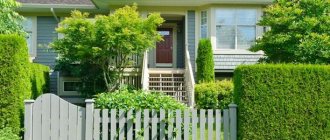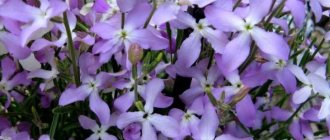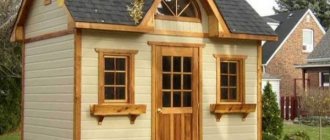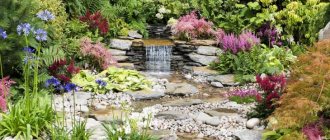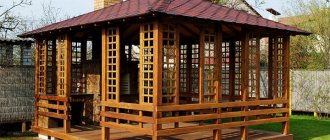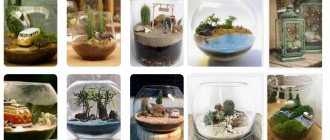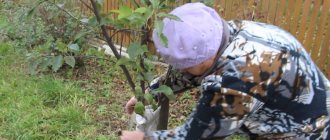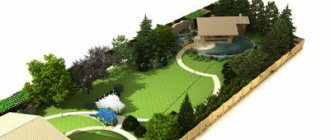If you want to plant coniferous plants in your dacha, then there will certainly be no problems with the assortment: today more than 700 species of the coniferous subclass and a large number of their garden forms are known.
But many of us don’t go to the dacha very often, or maybe we want to spend more time relaxing rather than caring for plants. In this case, your choice is the most unpretentious conifers that require minimal care from you.
The most resistant to cultivation are natural (natural) species, which, due to their considerable size, are suitable only for large summer cottages.
Therefore, we offer 13 of the most unpretentious conifers among decorative forms that will fit perfectly into the design of small cottages. We found the presented forms among junipers, pines and spruces.
Unpretentious varieties of junipers for the Moscow region and central Russia
Juniper Gold Cone
The largest number of non-capricious forms, tested by time and more than one generation of summer residents, are junipers. They grow well on fairly loose, moisture-absorbing, but not heavy soils, both in the sun and in partial shade; some tolerate heavy shade. When there is excess humidity, low-creeping forms are the first to suffer, so it is better to plant them in rockeries and on slopes.
In particular, spectacular compositions are obtained on the site in combination with ferns.
They are harmonious in tall flower beds as hanging plants.
Chinese juniper (Juniperus chinensis) 'Old Gold'
Luxurious juniper, completely justifying its name - “ancient gold”. It is almost like a cube: up to 2 m high and wide. The yellow-bronze color of the needles remains in winter. Very stable.
Juniperus horizontalis (J. horizontalis) 'Andorra Compact'
The horizontal juniper (J. horizontalis) is especially rich in unpretentious decorative forms, for example, the variety 'Andorra Compact'. This is a shrub with a cushion-shaped crown with a height of 0.3 to 0.4 m and a diameter of up to 1 m. The needles are small, scaly, bluish-gray-green, acquiring a slightly purple tint in winter. Light-loving, but tolerates slight shading. Grows well in moist, sandy soils.
Juniperus horizontalis (J. horizontalis) 'Blue Chip'
A slow-growing groundcover shrub for a small rocky home garden, 0.2 to 0.3 cm high and up to 1.5 m in diameter. The needles are silver-blue, slightly purple in winter.
Juniper horizontalis (J. horizontalis) 'Wilton'
Ground cover shrub, spreading in a dense low carpet. At the age of 10 years it reaches a height of 0.1 to 0.15 m. With such a small height, it spreads in width by 2-3 m or more. The needles are silver-blue. Suitable for growing in containers, harmonious in rocky gardens.
Juniperus horizontalis (J. horizontalis) 'Prince of Wales'
Dense low shrub 0.2 m high and approximately 2 m wide. The needles are scaly, thick, bluish-green, with a grayish-pink tint in winter. Grows best in open sunny places and tolerates slight shade.
Juniper (J. squamata) 'Blue Spider'
A very low juniper, only 0.3 m high, but growing up to 1 m wide, with amazingly beautiful emerald needles.
Cossack juniper (J. sabina)
Record holder for endurance! A powerful, rapidly growing species, height from 0.3 to 1.5 m, width from 1.0 to 2.5 m. Its needles are very beautiful.
You can select different types of juniper in our catalog, where products from many gardening online stores are presented. Select juniper seeds and seedlings.
Why don’t conifers take root in the country?
Initially, we want to describe the standard causes of disease in conifers in order to establish why some species do not take root in summer cottages.
Unsuitable climate for conifers
Perhaps you want to grow a plant in your dacha that prefers a frosty and dry climate, and your dacha is located in a region where the climate is different. It is quite possible that, on the contrary, the plant prefers humidity and sun, while your dacha is quite cold and drier. Climate problems are the most important, but they are also trying to get around them. Many people achieve this through adaptation, hardening, and proper preparation of seedlings. But it is more correct to immediately choose those plants that can take root in your climate.
Improper soil conditions
Some species of conifers grow and develop on sandstones all their lives, many can be seen in mountainous areas, among stones, but there are also those that prefer standard country soil. These are again adapted species that have been grown for many years within the city or dacha cooperative, receiving watering, bait, crown formation and other living conditions. These are the ones you should keep as a guideline, and also be sure to clarify on what soils your chosen conifer grows. It is quite possible that the dacha land will not suit him. You may have to choose a different species, or maybe try to create artificial conditions.
Poor quality of seedlings
If we assess the situation roughly, then more than half of the summer residents plant plants that they just liked. The second part consists of experienced summer residents or those who deal with plants professionally. But if we talk about the former, then it is quite difficult for them to choose high-quality seedlings, because even the criteria are sometimes unknown. Therefore, crippled conifer seedlings of the wrong varieties end up at dachas, initially infected with certain diseases, or those most susceptible to pests. The result is the same - the plant does not take root and quickly dies.
Improper care of coniferous plants
You can plant a spruce or pine tree in your dacha, but it is unknown how the coniferous plant will behave in a year or two. Therefore, it is necessary to provide the young tree with high-quality care. Increased attention is required during the first 5-7 years, and this is a mandatory requirement. In the future, it will also be impossible to leave the plant to its own devices - feeding, crown formation, and other care will be required.
It is very important to study the type of plant that is purchased and planted, and the requirements for its cultivation. You cannot use general rules, because each type is individual.
Negative internal environment
Each dacha has its own conditions for plants, which are regulated not only by the entire garden and vegetable garden, but also by neighboring dachas. The situation becomes clearer when you pay attention to the state of your farm. For example, you kill pests, but they appear again because neighbors on both sides of the street do not tend to their garden. The same goes for diseases of trees, shrubs and other plants that easily move from one dacha to another. This can also have a negative impact on conifers, which, for the most part, are quite whimsical.
In addition, pets and even children can be negative for young trees. If a seedling is broken by a dog or kids running around a young Christmas tree, it may not survive. You should create positive conditions for the young tree and try to care for new plants comprehensively. Perhaps in this case the result will be even better than you expected.
There are many reasons for poor growth of coniferous plants, but the main ones are listed above. Try to pay attention to every single detail and correct all the shortcomings. Then you will be able to grow a really healthy and beautiful coniferous plant in your dacha. But also think about the fact that choosing the right type, adapted or simply unpretentious, will help make the task easier!
Unpretentious pines for the Moscow region and central Russia
Pines are light-loving, grow well in open sun, and tolerate partial shade; are drought-resistant, grow well on poor soils and sands, but cannot tolerate stagnant waterlogging.
In plant compositions, pines are incredibly harmonious with many ground cover plants that love the sun: aubriet, saxifrage, borage; With red-leaved barberries, spectacular contrasting compositions are obtained.
Mountain pine (Pinus mugo) 'Winter Gold'
First of all, the forms of mountain pine (Pinus mugo) are unpretentious. These are dwarf coniferous pines, and here are two more unpretentious beauties.
This golden pine with a hemispherical, squat, unevenly developed crown shape on the sides is very consistent with its name - “winter gold”. Its needles are light green in summer and golden yellow in winter. After 10 years of growth, it reaches a height of approximately 0.5 m and a diameter of up to 1 m.
Mountain pine (P. mugo) 'Ophir'
This is another golden winter beauty (green needles in summer) from mountain pines. The incredibly regular, rounded shape of the crown becomes somewhat spreading and unequal with age. At the age of 10 years it reaches a height of 0.5 m and a diameter of 1 m.
Subtleties of caring for coniferous plants
The extent to which the decorative qualities of a coniferous plant will be revealed directly depends on proper planting and care during the first years of its life. Even the purchase of seedlings is carried out according to certain rules.
9 tips for planting and growing conifers:
- Seedlings should be purchased only in containers, in exceptional cases with a closed lump of earth on the roots;
- It is better to purchase seedlings from the nearest nursery, where they have already undergone primary acclimatization to local agroclimatic conditions;
- During planting, the root collar is located several centimeters above the soil level;
- Young seedlings are planted in the spring so that they have time to take root by autumn, and adult plants are transplanted during the dormant period, even in winter;
- After planting, young plants need abundant watering throughout the season;
- All conifers do not like stagnant moisture and swampy areas, so the planting pit is drained;
We use expanded clay for this - If the plants are not used for hedges, a distance equal to two times the height of an adult tree is left between them;
- For the first 5 years, the tree trunk circle is mulched to protect the root system from overheating under the sun in summer and freezing in winter;
- The area with conifers is protected from cold northern winds.
In addition, the peculiarities of growing each specific species should be taken into account. For example, attention is constantly paid to dwarf forms, and tall trees, after final rooting, do not require special care other than sanitary pruning. More time is allocated to caring for topiary, since their shape should be controlled by systematically cutting them.
Video from our specialist:
dizlandshafta
Unpretentious spruce trees for the Moscow region and central Russia
Spruce trees are quite shade-tolerant, grow well in damp, but not wetlands, and do not tolerate drought well! Among spruce trees, the following forms have proven to be quite stable in cultivation.
Norway spruce (Picea abies) 'Barryi'
A strong, slow-growing dwarf form of spruce. At the age of 10 years it reaches a height of 2 m. Young plants have a rounded crown shape, which is lost with age. The needles are shiny, dark green, young shoots are orange-brown.
Norway spruce (P. abies) 'Inversa'
An inverted weeping form with an extremely narrow, uneven crown due to shoots falling almost vertically downwards. The lower branches lie beautifully on the ground. The height of an adult plant is from 6 to 8 m, the width is approximately from 2 to 2.5 m. The needles are thick, dark green, shiny. Valued by conifer lovers due to its distinct individuality.
Norway spruce (P. abies) 'Nidiformis'
Unique nest-like dwarf form with a dense cushion-shaped crown. Since the main trunk is missing, shoots from . It grows very slowly: at the age of 10 years it reaches a height of 0.4 to 0.5 m, a width of 1 m. The needles are short. Extremely effective in small groups, rockeries.
The advantage of using coniferous plants
There are two main reasons why conifers are popular in landscaping private gardens. Firstly, they retain their green “outfit” 12 months a year. Green needles remain on the branches even in the most severe frosts, thanks to which the landscape with pines, spruces, junipers and other representatives of conifers always looks like a plus.
Secondly, most conifers do not require care. If the soil in the garden is not highly fertile, they will grow well in sandy and rocky soil. Well-rooted plants easily tolerate sub-zero temperatures, and in dry summers they get by with minimal watering.
The big advantage of coniferous plants is their small annual growth. This feature allows you to create compositions that remain stable for several years. To maintain the garden in its original form, only light trimming is required to maintain the shape of the crown.
The advantages also include not being capricious towards neighbors. They don’t care what grows nearby: roses, annuals, deciduous shrubs. The main thing is that this vegetation responds well to the presence of conifers and fits into the garden design.
Important. There is something that conifers don’t like - close-growing large deciduous trees with a spreading crown. In their shade, spruce and pine trees stretch out, the lower branches lose their needles and become bare.
Cedar
Cedar is decorative at any time of the year and can add uniqueness to any area. Low-growing varieties of plants are used for growing in gardens:
- Record card.
- Narcissus.
- Siberian pine variety "President".
Cedar is a supplier of useful products:
- nuts are used in medicine, cosmetology and cooking;
- resin promotes rapid healing of wounds;
- pine needles are indispensable in bath procedures.
The aroma of cedar filling the air will promote relaxation and good rest.
Strengths of dwarf spruce trees
Dwarf representatives of conifers are considered very attractive and the pricing policy is not inferior to the classic version. At the same time, we can highlight a number of advantages and strengths of growing dwarf spruce trees on the site.
- One on one with the original. Despite its dwarfism and compact size, the spruce has an identical structure to the classic version.
- Compact in placement. Dwarf spruce trees can fit into any landscape design and will be appropriately combined with the area, since they take up minimal space. WITH
- Stable composition. The advantage of dwarf versions is that you can foresee the landscape design in the coming years, nothing will change dramatically, so it will have its original appearance.
- Fits well into rockeries, rock gardens and rock slides. Spruce harmonizes well with stone, so it will combine beautifully in an unusual landscape.
- Versatility - for garden and indoors. Dwarf versions of fir trees can not only transform areas, but also become a New Year's beauty if they are fragrant in a container.
- Successful wintering. Dwarf spruces tolerate winters without problems, especially with heavy snow.
Varieties of dwarf spruce trees
Despite the clear definition of dwarfism in spruce trees, there is a certain gradation of these conifers, which helps to understand whether you are growing it or not. It all depends on the annual growth. Therefore, we can divide all dwarf representatives into groups:
- microdwarf spruce trees are those that during the growing season grow only a couple of centimeters, maximum 3;
- mini-dwarf spruce trees are conifers that increase the ground part by 3-8 cm per year of growth;
- dwarf spruce trees grow up to a maximum of 15 cm per year.
Of course, these data are approximate, so you shouldn’t check them strictly with a ruler.
Cypress
Cypress will make a stylish addition to the garden and will look great in a hedge. Its peculiarity is the specific density and symmetry of the branches.
The following decorative types are recommended:
- Siberian.
- McNab.
- Arizonan.
- Large-fruited.
All these varieties are frost-resistant and drought-resistant, and have a beneficial effect on the air and the environment. Cypress wood contains a large amount of resin, and the needles are an excellent raw material for preparing medicinal infusions.
Description of the most popular conifers with photos
Pine
They have long needle-like needles, large brown cones (they can stay on the branches for several years), young shoots grow strictly vertically, like candles. Most wild pines are tall, powerful trees - up to 15-20 meters. In the garden, medium-sized and low-growing species are most often used to create a frame around the site, and short ones are planted on alpine hills and rockeries. Pines are sun-loving plants and prefer light sandy soils. For a medium-sized plot, black pine, Wallicha, is best suited. Bushy and creeping mountain pines look very beautiful, and Weymouth pine is one of the most beautiful conifers with silver needles and can decorate the most sophisticated landscape design. Among the pines there are also dwarf varieties - the Pug pine, which is a perfectly round bush 45 cm tall.
Spruce differs from pine in its conical crown with whorled branches. Among the varieties there are huge giants: common spruce and Serbian spruce grow up to 20 m, and the gray Glauka barely reaches 1 meter. Spruce trees prefer calcareous soils and open sunny places. The most successful varieties:
- Nidiformis - bush-like flat crown with several tiers, the color of the needles is dark green with yellow shoots, height - about a meter;
- Reflexa is a creeping form used as a ground cover;
- The Acrocona variety has weeping long branches with bright red cones at their ends and will decorate any site design;
- One of the most spectacular is the type of Brewer spruce, with a wide conical crown, weeping branches with soft green young shoots;
- The best decoration for the garden will be blue spruce, of which there are now almost 30 varieties. For example, the Hoopsii variety, up to 2 m high, has needles so light that they appear white, while the Koster variety grows up to 7 m, and the very large needles shimmer with silver.
Fir
This luxurious tree, with its lush conical crown of a perfectly regular shape, resembles a Christmas tree. Fir leaves are flat, with a disc-shaped extension at the base, and below are white or gray in color, which makes them different from spruce. Wild firs are very large - 20-30 m. But now low-growing varieties have been bred - balsam fir does not exceed 90 cm in height and emits a simply fantastic aroma. Caucasian fir has bright yellow needles, while Korean varieties have dark green needles and lilac cones.
Araucaria
Among the many varieties, only one is frost-resistant - Chilean Araucaria. They are slow-growing plants - by the age of 10 they grow up to 1.5 m, but then add 30 cm every year. Its leaves have a triangular, pointed shape and wrap around the branches in a spiral. The lower branches have a rope-like shape and male cones grow there, looking like earrings. On the upper branches growing upwards, round female cones seem to be glued. Araucarias are shade-tolerant plants, but in full shade their lower branches are exposed, and they grow no higher than 8 meters.
Kalocedrus
This is one of the most elegant park plants, but many people confuse it with thuja, although their leaves are completely different. In Kalocedrus they are very small, scaly, with bent tops, and when rubbed they smell like incense. Refers to slow-growing plants. The variety with golden needles Aureovariegata barely grows to 1.8 m by the age of 10 years and will decorate any site design.
These mighty trees know everything. They grow well in parks, but for the garden you need to choose dwarf and low-growing forms. And the most beautiful ones are weeping cedars, although they are very expensive. There are cedars with yellow, gray and almost black needles. In adult specimens, cones appear that look like barrels, in which tasty nuts ripen in the second year. True, we have to wait twenty years for this.
Golovchatotis
This is one of the most beautiful and rarest conifers. It is a very neat bush with a bluish-gray crown. Excellent for cutting. All yews are shade-tolerant plants and can grow even in the shade of a house, on any soil. The maximum height is 2.5 m. A unique variety is Fastigiata, in which black needles are arranged in a spiral on the branches.
Cypress
This is a universal ornamental plant that comes in all shapes, sizes, and colors. It is distinguished from its relatives cypress and thuja by its needles and the shape of its branches - they are all in the same plane, and the leaves are small, similar to scales. This is the most affordable plant for creating hedges. The most common is the cone-shaped Loson cypress, which reaches 1.5 m by the age of 10, as well as the pea-bearing cypress - with blue needles.
Cryptomeria
The plants are native to Japan and reach 45 meters in height in the wild. Slow-growing varieties with red and bronze needles are popular here. By the age of 10, they grow 30-40 cm and are excellent for creating borders and alpine slides. The most beautiful variety of Vilmomaria.
Cunnigamy
This amazing plant surprises with its beauty. When young it has a cone-shaped head, and then grows up to 10 meters. But the most beautiful thing is the bright, shiny large pointed leaves, twisted in a spiral.
Kupresocioparis
This plant is also often found in our parks, and is often confused with cypress and thuja. It is distinguished by thin branches arranged like a fan in one plane. The color is green and yellow. Used to create tall hedges.
Cypress
This popular tree is not frost-resistant enough, so it is more often found in the southern regions. It differs from cypress in its large, lumpy, leathery cones. The peculiarity of cypress is that it must be purchased only with a closed root system - in a flowerpot or bag, otherwise it will definitely die. This is due to the structure of the root. The most spectacular columnar dark green forms are the varieties Stricta, Totem Pole, Golden Swan (with golden young shoots).
Juniper
These shade-tolerant plants are distributed all over the world and have probably the most varied varieties and species that will decorate any site design. Junipers have tiny but very sharp leaves, ranging in color from almost white, all shades of yellow, through blue and dove to dark green and brown. These plants are not very large - a maximum of 2.5 meters. But in shape - all types of crowns. The most valuable for the garden will be low-growing and dwarf species. Another advantage of junipers is that they lend themselves perfectly to shaping and make beautiful garden sculptures. Although, in their natural form they are much more decorative.
Footcarp (podocarpus)
At first glance, this plant bears little resemblance to a conifer and is extremely rare. This shrub has magnificent long flat needles up to 1 cm and cones in the form of red berries. These hardy and very decorative plants are best grown on an alpine hill or in a container. Frost resistance down to -20 degrees, and they grow extremely slowly.
Pseudotsuga
In nature, it is a huge tree up to 18 m. It is best to grow low-growing varieties - Glauka or Fletcher, which have sizes of 5 and 1.5 meters. Better yet, limit root growth to a buried container.
Sciandopitis
A very rare coniferous plant from Japan with whorled long leaves - up to 12 cm, similar to an umbrella, which is why it is also called “umbrella pine”. The cones are also large - up to 10 cm, the color of milk chocolate. It grows up to 6 m and can withstand even severe frosts.
This is the most unpretentious plant and resistant to the most difficult conditions. The leaves are dark green or yellow, some varieties are up to 3.5 cm long. Female plants produce bright red pseudoberries with seeds. It grows very slowly. Now about 150 garden varieties of yew have been bred - with crowns of various shapes and colors. Be sure to plant one in your garden!
Hemlock
A rare plant in landscape design due to its large size and sparse crown. However, there are now very charming, dwarf varieties with needles of different lengths on a single weeping branch. This is a magnificent Tsuga Pendula. If you come across this variety, don’t waste your money.
Our most famous conifer, the name after which all the others are named. These are truly universal plants - among them there is everything: any crown shape and size - dwarf thujas are now grown in collections, like cacti, and tall ones can be formed into the most exotic garden figures - spherical, cone-shaped, complex tiered shapes and others. And the best thing is to plant thujas with a certain shape and no longer bother with pruning.
In addition to those listed, there are about 10 more types of conifers that can be grown in the garden. We will describe them in the following articles.
Tips from Petrovna: which coniferous trees to choose and where to plant them
Hello, my dear! Not long ago, at one of the garden exhibitions, I unwittingly overheard a dialogue between two lovely ladies. “Look, what a wonderful Christmas tree!” – one of them clasped her hands. “This is not a Christmas tree, but a pine tree,” said the second one with conviction. Of course, I couldn’t resist being curious: the coniferous plant they liked turned out to be Canadian hemlock (Tsuga canadensis). It seems like a minor problem: gardeners are simply not familiar with this species, which is not yet very common among us. However, if they unknowingly plant it in unsuitable conditions, the hemlock will inevitably die.
Communicating with familiar summer residents, I have long noticed that many are extremely imprudent in purchasing conifers for their plots. I liked it and bought it, without thinking at all that each species (and often variety) needs certain conditions, without which the plant will develop poorly and possibly die.
Of course, more than one encyclopedia has been written about conifers. They discuss in detail the agricultural technology corresponding to each type, including a lot of details related to the characteristics of individual varieties. But, be honest, my dears, have any of you mastered these fundamental works? Can you, standing near the counter and looking at a pretty Christmas tree, remember what was written about it, for example, on page 327? That is why it is worth remembering a few simple rules that will help you quickly navigate at the right time. I was convinced of this from my own experience.
Larch
The highlight of the garden can be the spreading larch. A unique tree in the spring pleases with lush green needles, and in the fall the crown takes on golden-yellowish hues and gradually sheds its needles.
Larches are unpretentious and easily take root in urban environments. To decorate garden plots, breeders have developed many dwarf and weeping forms that can decorate and transform your garden.
European and Japanese larches have become widespread in the Russian climate.
